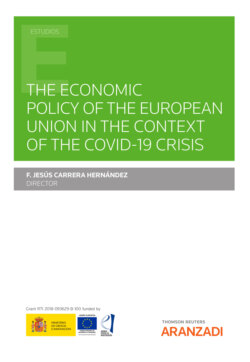Читать книгу The economic policy of the european union in the context of the covid-19 crisis - Francisco Jesús Carrera Hernández - Страница 9
На сайте Литреса книга снята с продажи.
4. BUDGETARY INSTRUMENTS FOR THE EURO AREA PRIOR TO THE HEALTH CRISIS
ОглавлениеIndeed, fully understanding the Commission’s proposal and the measures finally adopted requires taking into account the process of deepening EMU in which we have been immersed for years. Without going into more details, it is necessary to go back to December 2017, when the Commission launched a new package of proposals, including the Communication on new budgetary instruments for a stable euro area within the Union framework40. It proposed the creation of new budgetary instruments designed essentially for the euro area but integrated as a budget line within the EU budget, although external financing was also used. The concrete proposals were presented in May 2018. They sought to implement two new budgetary instruments41.
On the one hand, it proposed the launch of a European Investment Stabilisation Function (EISF)42: “the EISF will provide financial assistance in the form of loans and interest subsidies for the realization of public investment to the Member States that are experiencing a large asymmetric shock” (art. 1.2). The legal basis used (art. 175.3 of the TFEU) shows that it is an instrument at the service of cohesion in the EU, although “outside the structural funds” (see page 3 of the proposal). It is a mechanism available to the Member States of the Eurogroup and the Member States that participate in the Exchange Rate Mechanism II (Denmark). Under this mechanism, loans of up to 30,000 million euros could be granted together. The financing of this instrument is based on the “back to back” idea; in other words, the European Union may have recourse to financial markets or financial institutions to grant loans to the Member States (art. 12). The proposal foresees the creation of a Stabilization Support Fund that can be used to pay interest subsidies on loans. This fund is planned to be financed with contributions from the Member States.
On the other hand, it also proposed the reinforcement of the already existing support program for structural reforms foreseen in Regulation 2017/825, also reinforcing technical assistance from 202043. As in the previous case, it is configured as an instrument of cohesion, so art. 175.3 of the TFEU is the legal basis. However, in this case art. 197.2 of the TFEU is added, insofar as this instrument also aims to strengthen the administrative capacity of the Member States. This program was to be endowed with 25,000 million euros for the three instruments it contains: an operational reform tool, a technical support instrument and a convergence mechanism for the preparation to join the euro area.
However, the first of the aforementioned contents is the most relevant (operational reform tool) and an allocation of 22,000 million euros is proposed to provide the Member States without distinction with financial incentives to achieve the intermediate objectives and goals of the structural reforms established in the reform commitments adopted by the Member States with the Commission (art. 5). In short, to provide financial assistance to the Member States in order to carry out the necessary reforms committed to within the framework of the European Semester, an outstanding debt in the design of the economic policy of the European Union. This is a financial contribution from the Common Budget that does not require national co-financing. The States concerned must submit a proposal for reform commitments and, if it is accepted and they receive the expected financial assistance, they will use the current National Reform Programs (NRP) as a means of informing the Commission of the progress they are making.
Taking into account the new figures adopted, the recovery instrument, and more specifically the recovery and resilience mechanism, constitute a qualitative and quantitative, albeit temporary transformation of the intended objective of introducing new budgetary instruments to support the reforms and investments of the Member States within the framework of the European Semester. A spectacular quantitative improvement of the Reform Support Program and the European Investment Stabilization Function as a consequence of the new circumstances generated by the pandemic.
The new circumstances have made it necessary to vary the work program and the measures that the European Commission had already proposed, which are the reason why the proposal for the support program for structural reforms has been withdrawn. As could not be otherwise, the proposal for a Regulation on a governance framework for the convergence and competitiveness instrument for the euro area, envisaged under the Reform Support Program, is also replaced44.
Finally, while the mechanism is being created, a technical support instrument is also being introduced which, in addition to offering the Member States with the necessary institutional and administrative capacity to develop and implement reforms, assists them in the preparation and implementation of recovery and resilience plans under the RRM45. It is endowed with 864 million euros for the period 2021-2027. However, this instrument does not represent any novelty. A similar instrument was already foreseen in the Commission’s 2018 proposal for a new structural reform support program for the period 2021-2027. It is therefore the successor to the Structural Reform Support Programme (SRSP or PARE)46.
